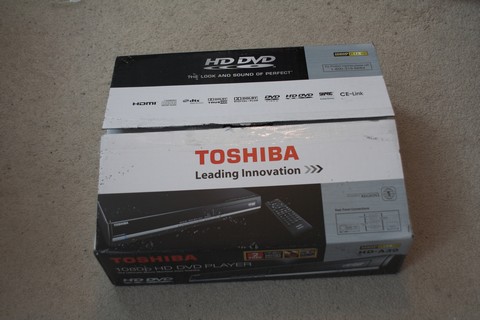Cracking open a Toshiba HD-A30 HD DVD player

Updated 3:00AM - By now the news is out that the end of HD DVD might be near since Toshiba is considering its options that may include the possibility of stopped production on HD DVD products is confirmed dead. There are more than a million HD DVD owners, two exclusive HD DVD studios, and the adult movie industry who are now left holding the bag on an optical disk format with no future.
While it may be a sad day that the more affordable and fully-baked format lost, I know many friends who bought one of these sub-$150 players as a great 1080i or 1080p up-converting DVD player which happen to come with 7 HD DVD movies. A common consensus is that while Blu-ray may have "won" the format wars, a lot of people aren't in the mood to jump over to the $300 Blu-ray set-top boxes that can't be upgraded to Blu-ray profile 2.0 next year and they'll be left with another obsolete high definition player.
Since I have the opportunity to review my friend's Toshiba HD-A30 which is the pinnacle of HD DVD set-top boxes and might be the last production HD DVD drive ever, I thought I'd crack it open and take a look inside. See higher resolution gallery here.
This $150 1080p up-converting HD DVD player comes with 2 HD DVD movies (300 and Borne Identity) out of the box. It also has a coupon offer for an additional 5 free HD DVD movies. Given the fact that a discount HD DVD movie goes for $15 while the newer ones are $25, this seems to be worth at least $105 in HD DVD movies. The fact that existing DVDs look great on it when played on a 1080i or 1080p display seems to be a nice bonus.
Just what we need, another remote control to add to my collection of dozens of remote controls. This remote seems to be a simple and straight forward infrared remote with no backlighting and it works well enough. The menus in the HD DVD titles are fairly responsive and they work and overlay the main feature while the movie is playing.
Here's the Toshiba HD-A30 unit sitting on a table and it's fairly small and light weight. I measured idle power consumption to be around 22 watts and peak consumption around 28 watts during HD DVD playback which is a vast improvement over the first generation HD DVD players which consumed around 60 to 80 watts. Boot times still seem a bit disappointing at one minute long and there's no low-power sleep state with instant wake but this seems to be a problem with the Blu-ray set-top boxes as well.
After popping off a few screws on the Toshiba HD-A30, the cover came off. You can also see what the back looks like. It comes with an RCA audio/video standard definition output, an HDMI HDCP output, an analog component HD output, and a S/PDIF digital audio output. The Ethernet port is standard on all HD DVD players for future upgradeability and interactive features.
Here's a topside view of the Toshiba HD-A30 with the covers off. It's a fairly simple device with an embedded motherboard with CPU and graphics processors on the right, an HD DVD ROM drive on the left, and an open frame power supply on the lower left. The very first Toshiba HD DVD drive used a Pentium 4 2.4 GHz processor while this one uses something that has much lower power consumption with passive cooling. Since the CPU heat sink was glued on, I didn't want to rip it off and damage my friend's unit so I didn't see what the chip was. The memory, GPU, and CPU are all soldered directly on to the motherboard. In theory, this would make a decent $150 media extender that hooks up to any high-definition monitor if we could put in a hacked operating system. In theory it could be turned in to a computer but it lacks USB ports for hooking up input devices.
The Toshiba HD-A30 seems to be using a miniature 40-pin PATA IDE connector for the optical drive and a small 3.5" floppy drive power connector. You can see the thin 40-pin ribbon taped down to the chassis.
This is a close-up of the motherboard.
